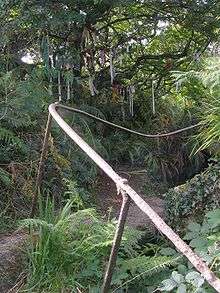Clootie well
Clootie wells (also Cloutie or Cloughtie wells) are places of pilgrimage in Celtic areas. They are wells or springs, almost always with a tree growing beside them, where strips of cloth or rags have been left, usually tied to the branches of the tree as part of a healing ritual. In Scots nomenclature, a "clootie" or "cloot" is a strip of cloth or rag.
Practices

When used at the clootie wells in Scotland and Ireland, the pieces of cloth are generally dipped in the water of the holy well and then tied to a branch while a prayer of supplication is said to the spirit of the well – in modern times usually a saint, but in pre-Christian times a goddess or local nature spirit. This is most often done by those seeking healing, though some may do it simply to honour the spirit of the well. In either case, many see this as a probable continuation of the ancient Celtic practice of leaving votive offerings in wells or pits.[1][2]
There are local variations to the practice. At some wells the tradition is to wash the affected part of the body with the wet rag and then tie the washing-rag on the branch; as the rag disintegrates over time, the ailment is supposed to fade away as well. At some wells the clooties are definitely "rags" and discards, at others, brightly coloured strips of fine cloth. In some locations the ceremony may also include circumambulation (or circling) of the well a set number of times and making an offering of a coin, pin or stone. Additional votive offerings hung on the branches or deposited in the wells may include rosaries, religious medals, crosses, religious icons and other symbols of faith.[1][2]
At clootie wells where the operative principle is to shed the ailment, and the clootie is thought to represent the ailment, the "offerings" may be grotesque castoffs. Those that instead view the clootie as an offering to the spirit, saint or deity are more likely to tie an attractive, clean piece of cloth or ribbon.[1][2]
The sacred trees at clootie wells are usually Whitethorn trees, though Ash trees are also common.[1][2]
The most popular times for pilgrimages to clootie wells, like other holy wells, are on the feast days of Saints, the Pattern or Patron day, or on the old Gaelic festival days of Imbolc (1 February), Beltane (1 May), Lughnasadh (1 August), or Samhain (1 November).[2][3]
Locations

In Scotland, by the village of Munlochy on the A832, is a clootie well at an ancient spring dedicated to Saint Curetán, where rags are still hung on the surrounding bushes and trees. Here the well was once thought to have had the power to cure sick children who were left there overnight. Craigie Well at Avoch on the Black Isle has both offerings of coins and clooties. Rags, wool and human hair were also used as charms against sorcery, and as tokens of penance or fulfilment of a vow.[4]
In Cornwall, at Madron Well (SW446328) the practice is to tie the cloth and as it rots the ailment is believed to disappear.[5][6] Alsia Well (SW393251) and Sancreed Well (SW417293) are other Cornish "cloughtie" wells.[5] Christ's Well at Mentieth was described in 1618 "as all tapestried about with old rags".[4]
In Ireland at Loughcrew, Oldcastle, County Meath (53°44′36″N 7°08′03″W / 53.743299°N 7.134040°W) there is a wishing tree, where visitors to the passage tombs tie ribbons to the branch of a hawthorn tree. Loughcrew is a site of considerable historical importance in Ireland. It is the site of megalithic burial grounds dating back to approximately 3500 and 3300 BC, situated near the summit of Sliabh na Caillí and on surrounding hills and valleys.[7]
Popular culture
A fictional clootie well at Auchterarder and the one on Black Isle feature in Ian Rankin's novel The Naming of the Dead. Author Ian Rankin visited the Clootie Well at Munlochy, on the Black Isle before writing the book.
See also
References
- 1 2 3 4 Healy, Elizabeth (2002) In Search of Ireland's Holy Wells. Dublin, Wolfhound Press ISBN 0-86327-865-5 pp. 12–19, 27, 56–7, 66, 69, 81.
- 1 2 3 4 5 Logan, Patrick (1980) The Holy Wells of Ireland. Buckinghamshire, Colin Smythe Limited. ISBN 0-86140-046-1. pp. 22–3, 95.
- ↑ Healy (2002) p. 19.
- 1 2 Sharp, Mick (1997) Holy Places of Celtic Britain. London, Blandford. ISBN 1-85079-315-8. p. 172.
- 1 2 Straffon, Cheryl (1998) Fentynyow Kernow – In Search of Cornwall's Holy Wells Penzance, Meyn Mamvro. ISBN 0-9518859-5-2 pp. 40–42.
- ↑ Rundall, Charlotte (Ed.) (1998) "The Magic of Cornwall" in Reader's Digest pp. 51–52.
- ↑ "Wishing Tree on the path to Loughcrew:: OS grid N5877 :: Geograph Ireland – photograph every grid square!". Geograph.ie. Retrieved 6 November 2011.
External links
- The Clootie Well, Munlochy
- Pictures of the Clootie Well, Munlochy
- Ireland – Rag Trees
- Irish Holy Wells – some with rags and ribbons
- A mention of the Clootie Well of St Curidan (Scotland)
- Doon Well, a renowned Holy well in Co. Donegal
- Irish Landmarks: The Holy Wells of Ireland
- The Megalithic Portal Includes Holy wells and sacred springs.]
- Video footage of Saint Queran's Clootie Well.